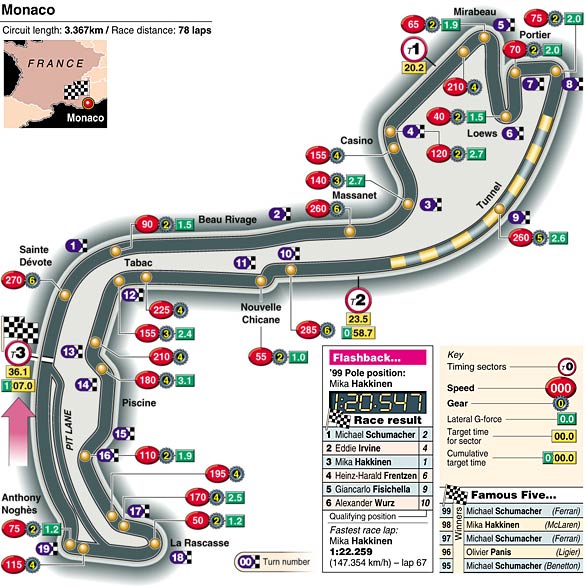|
| |||
 |
A Lap of Monaco | ||
|
The Monaco Grand Prix was first held at 1929 and mazingly, it has changed very little since then, with just one or two modifications, but the basic shape remains familiar: the blast to the first corner - Ste Devote - up the hill to Massenet, then Casino corner and its favourite bump on the exit. Down the hill to Mirabeau - or Upper Mirabeau corner as it appears on some maps.
Then comes the slowest corner on the circuit, now called Grand Hotel, before the often unnamed right-hander, but called Lower Mirabeau on maps. Then there's the right handed sea-side Portier, followed by the tunnel, to the chicane followed by the short blast to Tabac. Then they wind around the swimming pool to Rascasse, a left and then hard right, followed, finally, by Virage Anthony Noghes, named after the man who, as president of the newly formed Automobile Club de Monaco, applied to the then governing body to hold a motor race around the Principality, back in 1928. Since then, as a Grand Prix, it has earned many superlatives: the most scenic, the most prestigious, the most expensive, the most difficult to work at... The list is extensive. It does, of course, have the shortest lap in Grand Prix racing at 3.367 kms and it is, of course, the slowest race at 147.354 kph last year, but only 106.937kph in the rain in 1997.
 A lap of Monaco with Benetton's Giancarlo Fisichella: "The lap starts on the pit straight where I will reach over 270 km/h in 6th gear, before braking to 2nd gear and around 86 km/h for the Sainte D?vote corner. From here I accelerate up the long hill reaching about 260 km/h before going into the long left-hand 3rd gear corner which is taken in 3rd and leads to the famous Casino corner. "I remain in 3rd gear for this and take it at around 120 km/h and as I crest the hill the car becomes very light and slides towards the barrier. Then there's a very bumpy, highly cambered straight on which the car reaches around 210 km/h and which leads down to the first of the 1st gear hairpins, the Mirabeau hairpin, which is taken at under 70 km/h. There's a very short period of acceleration which leads down to the tightest of all the corners at Monaco, the Loews hairpin which again is taken in 1st gear and the speed can be as low as 45 km/h. "The downhill stretch leads to the two corners that go into the tunnel, both of which are taken in 2nd gear at under 80 km/h. As you enter the tunnel its quite tricky because you not only have to get used to a change in the ambient light, but there is also quite a difficult corner in the tunnel which is taken at over 250 km/h in top gear. On exiting the tunnel braking is very difficult for the chicane as you are heading downhill and have to brake from the maximum speed on the circuit of 280 km/h down to around 60 km/h and 1st gear for the Harbour chicane. "From here I will reach around 225 km/h before going through the Tabac corner in 4th gear at around 160 km/h. I remain in 4th gear for the first, fast, part of the swimming pool area, before braking to 2nd gear and 80 km/h for the second part of the swimming pool. The approach to the final hairpin, the Rascasse, is very difficult as you have to brake from around 185 km/h while still on a curve, down to 50 km/h for this 1st gear corner. On exiting this corner it is very difficult to control the wheelspin as you accelerate up to the final corner which is taken at around 75 km/h in 2nd gear. The lap then finishes on the pit straight."
Of course, Senna might have won again in 1984 but the race was stopped on lap 31 of 77, Alain Prost signalling to race officials that the wet conditions were too dangerous. (Some will say Stefan Bellof might also have won as he, like Senna, was gaining on Prost, but the Tyrrells were subsequently disqualified from that year's World Championship). That was the first time the race was stopped. It was stopped again in 1990 and 1995 because of first lap accidents, and it was stopped at the two hour mark in both 1996 and 1997 because of rain.
David Coulthard's pole meant that McLaren equalled Lotus on 107 poles, one behind Williams on 108, and 22 behind Ferrari. And Michael Schumacher's fastest lap put him equal in the all-time rankings with Alain Prost on 41.
|
| Atlas F1 | © 2000 Kaizar.Com, Incorporated. |
| Send comments to: comments@atlasf1.com | Terms & Conditions |